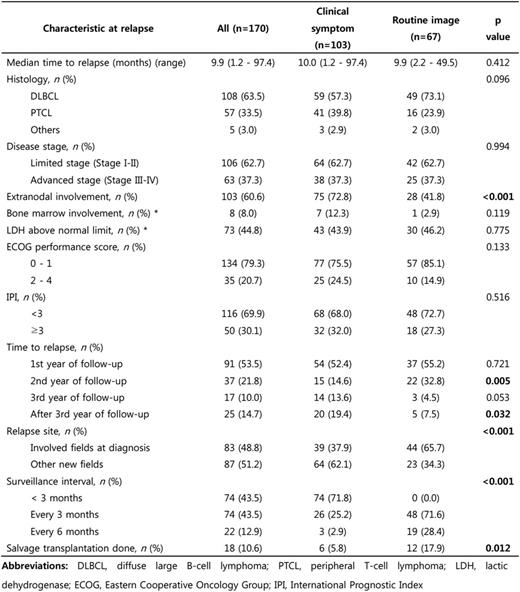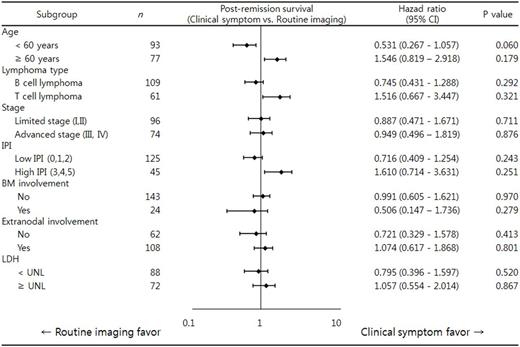Abstract
Purpose
Routine imaging is commonly performed as a surveillance practice to detect the relapse of aggressive non-Hodgkin's lymphoma (aNHL) after achieving complete remission (CR), based on the expectation to discover progression before the appearance of symptoms associated with disease. However, there are limited data on the benefits for routine imaging for surveillance. In addition, there are concerns about the radiation hazards such as secondary malignancies. The purpose of this study is to determine whether routine radiologic imaging is beneficial to detect the asymptomatic relapse of aNHL and to improve the post-relapse survival by salvage chemotherapy. For this purpose, we retrospectively analyzed patients with aNHL who achieved CR after frontline chemotherapy.
Methods
We conducted a retrospective chart review of patients with aNHL (diffuse large B-cell lymphoma, peripheral T-cell lymphoma, Burkitt's lymphoma, and lymphoblastic lymphoma) who achieved CR after frontline chemotherapy between June 1995 and March 2016. All patients were followed with clinical visits (history taking, physical examination, and laboratory tests) every 1 to 6 months, and routine imaging (CT: involved fields or whole body) was performed every 3 or 6 months, according to the physician's preference. Cases with identified relapse were categorized into a clinical symptom-based group or routine imaging-based group. The primary endpoint was post-relapse survival (PRS) in each group. In addition, PRS according to surveillance interval was evaluated in each group, and subgroup analysis to determine the benefit of routine imaging was performed. PRS was defined as the time interval from the date of identified relapse to the date of death. PRS was evaluated using the Kaplan-Meier method and compared using the log-rank test. Subgroup analysis was performed using the Cox proportional hazard method.
Results
Of 1,349 patients diagnosed with aNHL, 629 achieved CR after frontline chemotherapy, and 170 relapsed. Median follow-up duration was 51.6 months. Relapse was detected by clinical symptoms in 103 patients (60.6%) and by routine imaging in 67 (39.4%). Median time to relapse was similar between the 2 groups (10.0 months vs. 9.9 months, p= 0.412). The routine imaging-based group had less extranodal involvement at relapse, but other characteristics including stage were similar (Table 1). PRS did not differ whether relapse was detected by clinical symptoms or by routine imaging (36.8 months, range: 7.2-66.4, vs. 36.0 months, range: 11.1-60.8; p = 0.754). Among patients with relapse detected by routine imaging, there was no statistical difference in PRS between 3- and 6-month intervals (p = 0.705). Routine imaging showed marginal significance in the subgroup of patients lesser than 60 (Table 2).
Conclusion
These results might suggest that thorough history and physical examination is the more important surveillance tool than routine imaging to detect the relapse of treated aNHL. However, the usefulness of routine imaging for the detection of asymptomatic aNHL relapse was also observed in patients lesser than 60. So, further studies will be warranted to establish the guideline for surveillance of treated aNHL patients to detect disease relapse early and efficiently.
Subgroup analysis of post-remission survival according to the relapse detection method
Subgroup analysis of post-remission survival according to the relapse detection method
No relevant conflicts of interest to declare.
Author notes
Asterisk with author names denotes non-ASH members.



This feature is available to Subscribers Only
Sign In or Create an Account Close Modal